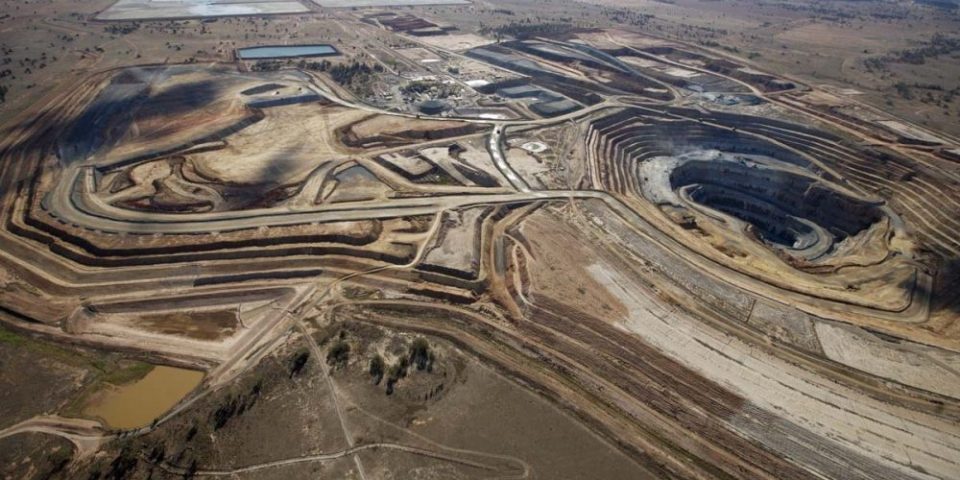El Gobernador de Wisconsin aprobó una resolución por la cual, antes de permitir la operación de cualquier mina que use ciertos químicos, las empresas DEBEN PROVEER PRUEBAS CONCLUYENTES DE ALGUNA OTRA MINA QUE HAYA OPERADO POR DIEZ AÑOS CON ESOS MISMOS QUIMICOS (Y QUE LUEGO HAYA ESTADO CERRADA POR OTROS DIEZ AÑOS) SIN CONTAMINAR EL AMBIENTE.
http://www.zmag.org/Bulletins/Palgom.htm
Wisconsin: Mining Moratorium Law
Also: Make Rio Algom AllGone!
Mining Moratorium to Become Law
**************Please circulate********************
Wisconsin Governor Tommy Thompson has announced that he will sign the Sulfide Mining Moratorium Bill (SB3) in April. The bill will require companies to provide one example of a sulfide mine which has operated for ten years (and been closed for ten years) without polluting the surrounding environment, before any company can get a mine permit.
“The Moratorium does NOT stop the permit process for Rio Algom's proposed Crandon mine, but does add a seemingly insurmountable hurdle at the end of the process– proof that a safe sulfide mine exists,” said Zoltan Grossman, a Madison spokesperson for the Wolf Watershed Educational Project and Midwest Treaty Network. Grossman noted that Thompson is also backing down on his insistence that Wisconsin tribes trade gaming rights for their environmental and treaty rights–at least until after the November election. He added, “Moratorium backers should be on guard against any future attempts to undermine the letter or spirit of the new law.”
In February, the bill passed the State Senate 27-5 and the State Assembly 91-6, before the normally pro-mining Republican Governor said in a March 20 statement that he would sign it into law, under heavy political pressure from a strong grassroots environmental movement. Alice McCombs, president of EarthWins, a Shawano- based international group that supports activism against unsafe mining, said that a mining lobbyist effort to weaken the bill had earlier been reversed by a one-vote margin in the Senate, after initial success in the Assembly.
Wisconsin has a long history of strong environmental consciousness, as demonstrated by the teachings of John Muir, Aldo Leopold, Chief Oshkosh, Hilary Waukau, and Evelyn Churchill (the originator of the sulfide mining moratorium). Passage of the Moratorium is due to the efforts of an historic grassroots alliance of environmentalists, Native American nations, sportfishing groups, unionists, students, and others around the state. They oppose the proposed Crandon mine (and a planned Northern Wisconsin mining district) for its threat to fish in the Wolf and Wisconsin rivers, the tourism economy, and Native American cultures.
The Crandon zinc-copper mine site is one mile upstream from the wild rice beds of the Mole Lake Sokaogon Chippewa Community, five miles downwind from the Forest County Potawatomi Community, and about 40 miles upstream from the Menominee Nation (via the Wolf River). Wisconsin tribes and sportfishing groups have been in conflict over treaty-backed fishing rights, but have joined forces against the mining threat to the fishery. Polls show that a majority oppose the Crandon mine, which has become the number one environmental issue in the state.
Opposition to the proposed Crandon mine is not limited to Wisconsin. On January 28, Michigan Governor John Engler sent a letter to Governor Thompson challenging Wisconsin's Great Lakes water diversion for a proposed 38-mile mine waste pipeline to the Wisconsin River. New York Governor George Pataki also raised concerns about the precedent-setting diversion. McCombs said, “Governor Engler's letter is a strong indication that opposition to the proposed Crandon mine is also growing within the Great Lakes region and the continent.” Exxon originally headed the Crandon mine project, but in January sold its interest to its Toronto-based partner Rio Algom, Ltd., which put its new subsidiary Nicolet Minerals Company in charge of the project, currently undergoing state and federal permit processes.
Contact: Zoltan Grossman (608) 246-2256,
Alice McCombs (715) 524-5998
For other phone numbers, see
http://www.alphacdc.com/treaty/speakers.html
——————————————————————————–
Despite a million dollar PR campaign and intense pressure by mining lobbyists, Wisconsin has passed the Sulfide Mining Moratorium Bill. The bill requires companies to provide one example of a sulfide mine which has operated for ten years and closed for ten years without polluting its surrounding environment before any company can get a mine permit.
Wisconsin has a long history of strong environmental consciousness, as demonstrated by the teachings of the late John Muir, Aldo Leopold, Chief Oshkosh, Hilary Waukau, and Evelyn Churchill. The passage of Churchill's Moratorium is due to the efforts of an historic statewide alliance of environmentalists, Native American nations, sportfishing groups, unionists, students, and others who have clearly shown their opposition to sulfide mining:
40,000 Wisconsin citizens signed a petition supporting the Moratorium;
99 counties, cities, villages, and towns have passed resolutions and/or legislation or have gone on record in opposition to the Crandon Mine, its proposed waste pipeline to the Wisconsin River, or sulfide mining in general;
At least 76 Wisconsin municipalities and organizations back the Moratorium;
A poll conducted in October 1997 by Chamberlain Research Consultants for Wisconsin Wildlife Federation showed that 52.5% oppose the proposed mine.
Local town boards that have backed mining have been ousted by voters.
People are not fooled by glitzy propaganda and junk science. With the recent Moratorium passage, and escalating opposition to the proposed Crandon mine, it should be obvious that the days of Rio Algom, Ltd. in Wisconsin are numbered. The longer Rio Algom stays in Wisconsin, the more the concept of a mining moratorium will spread to other states and provinces, and the larger the spotlight will be shown on Rio Algom mining practices throughout the Western Hemisphere.
Rio Algom should gracefully exit this doomed project now, in the interest of its shareholders.













